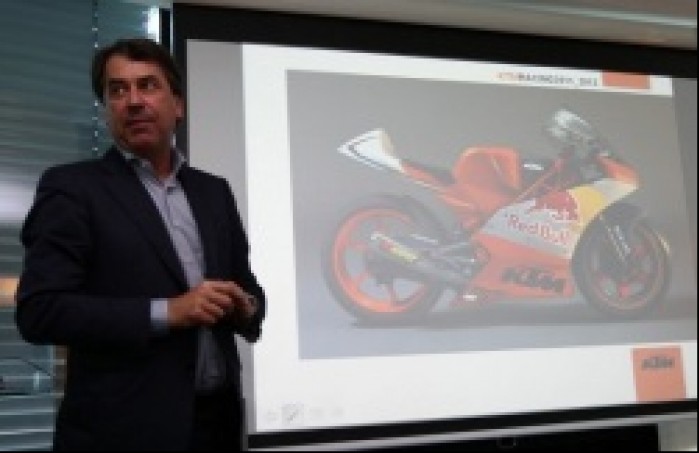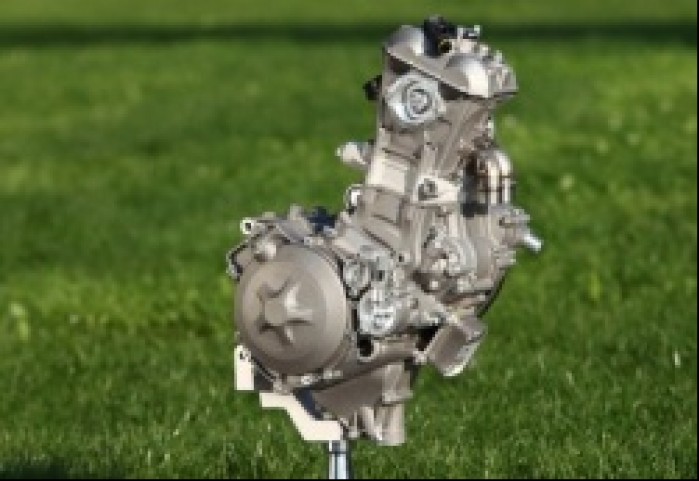|
Engine
- 4-stroke reciprocating piston engines only.
- Engine capacity: maximum 250cc.
- Single cylinder only.
- Maximum bore size: 81mm. Oval pistons are not permitted.
- Engines must be normally aspirated. No turbo-charging, no super-charging.
- Crankshaft speed limited to maximum: 14,000 rpm.
- Pneumatic and/or hydraulic valve systems are not permitted.
- Valve timing system drive must be by one chain.
- Variable valve timing and/or variable valve lift systems are not permitted.
Engine Supply
- The engine is defined as the complete engine including intake system (throttle body, injectors), and one complete transmission.
- The maximum price of the engine must not exceed 12,000 Euros. No optional parts or service contracts may be used to circumvent this price limit.
- If the engine is sold as a base unit plus 'tuning kit' then the total price of original engine & kit must not be more than 12,000 Euros. The base unit manufacturer is considered as the engine manufacturer.
- In order to ensure this price limit, any Team competing in the race will be granted the right to buy the engine used in the race from another Team, at the end of the race for a fixed price of 12,000 Euros (details TBA).
- Each engine manufacturer must undertake to supply sufficient engines and spare parts to supply 15 riders per season, if requested, and is responsible that the same amount of tuning kits (if any) are available, regardless where the tuning kit comes from.
- For a manufacturer entering the Moto3 championship for the first time, the minimum engine supply requirement will be 8 riders during that first season only.
- The minimum supply number may be comprised of complete motorcycles or separate engines.
- This minimum supply applies to each separate engine specification offered by the manufacturer.
Engine Parts
- Each engine manufacturer must submit a price and lead-time list of all the parts of the engine (which are considered the 'stock' parts) for the season for approval by the Organiser and may not charge more than these published prices. Approval is based on the prices and lead-times being in line with current market norms for these parts and technologies.
- In the event of engine updates or upgraded parts being developed, these must be made available to all customers at the same time, and respecting the price limits described.
Inlet, Fuel System & Lubricant
- Variable-length inlet tract systems are not permitted.
- Only one throttle control valve is permitted to control the power demand by the rider, which must be controlled exclusively by mechanical means (eg. cable) operated by the rider only.
- Fuel injectors must be located upstream of the engine intake valves.
- Maximum of 2 fuel injectors and 2 independent fuel injector drivers.
- Relative fuel pressure must not exceed 5.0 bar.
Exhaust system
- Variable length exhaust systems are not permitted.
- No moving parts (e.g. valves, baffles) are allowed in the exhaust system.
- Noise tests will be according to FIM Grand Prix Regulations. Test rpm: 5,500. Maximum permitted noise level: 115 dB/A.
Transmission
- A maximum of 6 gearbox speeds is permitted.
- A maximum of 2 possible gear ratios for each gearbox speed, and 2 possible ratios for the primary drive gear is permitted. Teams will be required to declare the two gearbox ratios chosen for each gear at the beginning of the season, and only these ratios may be used during the entire season.
- Gearbox systems must be of the conventional type. That is: constant-mesh with engagement dogs as an integral part of the gear, actuated by shift forks and shift cam or drum, with only one set of gears engaging at one time. So-called 'seamless shift' transmissions (also known as Automated Manual Transmission, Instantaneous Gearchange System) are not permitted.
- Electro-mechanical or electro-hydraulic clutch actuating systems are not permitted.
Ignition, Electronics & Data-Logging
- Only the ignition/fuel injection control units (ECU) approved by the series Organiser are allowed. This ECU must remain unmodified in hardware and software, as delivered by the Organiser.
- During Moto3 race events only the official 'Race' version of ECU software supplied by the ECU manufacturer may be used to write to (flash) the ECU. The only permitted changes are the setting (tuning) options included in this software.
- The Technical Director may require the team to change the ECU on any machine for another standard one at any time.
- This official ECU will include an engine rpm limiter.
- This official ECU will include an inboard data logger, and no other additional data loggers may be used.
Chassis
- Chassis must be a prototype, the design and construction of which is free within the constraints of the FIM Grand Prix Technical Regulations.
- Minimum total weight of Motorcycle + Rider: 148kg
- Brake discs must be made from ferrous materials.
- Suspension systems must be of a conventional, mechanical type.
Materials & Construction
- Camshafts, crankshafts, piston pins must be made from ferrous materials. Inserts of a different material are allowed in the crankshaft for the sole purpose of balancing.
- Engine crankcases, cylinder blocks and cylinder heads must be made from cast aluminium alloys.
- Pistons must be made from an aluminium alloy.
- Connecting rods, valves and valve springs must be made from either ferrous or Titanium-based alloys.
General
- Number of machines: the team can present only one motorcycle per rider for technical control. Replacement motorcycles may only be used subject to Article 1.15.3 of the FIM Grand Prix Regulations
- Number of engines: a maximum of 8 engines per rider may be used during all Grand Prix race events comprising the season. A rebuilt engine will be counted as a new engine.
|












Komentarze 2
Pokaż wszystkie komentarzeSzkoda ze nie wykorzystali seryjnych silników crossowych 250 4t, byłoby jeszcze taniej, producenci byliby rózni a podwozia i ramy i tak zostałyby prototypowe.
Odpowiedzparametry tych sprzęcików powalają. no ale przeccież to prototypy
Odpowiedz